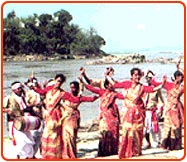Assam being a land of composite culture reflects a chain of festivals of different tribes throughout the year.
It's as if people cross the threshold to come together with festive abandon and momentarily forget their tough lives.
The perfect fusion if heritage of tribes and subtribes has made Assam the home of the most colorful festivals. The major festival of Assam is Bihu in three forms, viz.Bohag Bihu or Rongali Bihu in April,Magh Bihu or Bhogali Bihu in January and Kati Bihu or Kongali Bihu in October/ November.
Rongali Bihu is celebrated by most of the races that inhabit there in their own colors and names. Thus parallels of Bihu among the races are Baisagu for Bodo Kacharis, Baikhu for Rabhas, Ali- Ai -Ligang for Misings, Bohhaggio Bishu for Deoris. Contemporaries of Magh Bihu are Nara-siga Bihu of Miring, Pushy Par. or Tushu Puja of tea tribe of Assam. Other community festivals of Assam are Rongker of Karbis, Rajini Gabra and Harni Gabra of Dimasa tribe.
The simplicity of Assamese people is reflected in their celebration. Festivals take place in a communal way, usually in a Namghar or in open space. Bamboo sticks and banana leaves are profusely used and rather than offering cooked food, nutritious food such as sprouted grams and fruits are offered during worship.
The "Bohaag Bihu" (also called as "Rangali Bihu" or the Festival of Merriment) marks the beginning of the New Year - the seeding time. The "Kaati Bihu" ( also called as "Kongaali Bihu" or the Festival of the Poor) marks the completion of sowing & transplanting of paddies. The "Maagh Bihu" (also called as "Bhogali Bihu" or the Festival of Food) marks the end of the harvesting period. Of all the three the Bohaag Bihu is the period of greatest enjoyment, marking the arrival of spring season.
The Rangali Bihu is a dance festivel. The highlight of this dance is a group of young boys and girls, dancing in separate groups with drums beats & pipes. On its eve, the womenfolk clean the clothes and prepare special Bihu delicacies like 'Chira' & 'Pitha'. The menfolk collect necessary items like 'Tara Pogha' (ropes for the cattle) and vegetables like raw turmeric, brinjal, gourd etc.
Magh Bihu or Bhogali Bihu (derived from the word 'Bhoga' meaning eating or enjoyment) is celebrated when the harvesting is over. It is a harvest festival. On the eve of Bihu day, called "Uruka", women prepare rice cakes and other refreshments. The most significant part of this day is the building of 'Meji' and feasting at night. The whole night is spent in feasting, merry - making dancing and singing.
Kati Bihu or Kangali Bihu (Poor Bihu) is celebrated at the time when paddy seedlings begin to grow. In the evenings, offerings are made to the 'Tulsi' plant. Little earthen lamps ('Diyas') are lighted at its feet and puja's are offered to God for improved yield of crops.
The significance of this Bihu is more in the villages, where farmers go to their respective fields and light "Akash-Banti" or 'sky-lamp' hanging from a tall bamboo, to ward off pests and other insects.




 Beautiful agricultural state of Assam celebrates major agricultural events as the festival of Bihu. Notably there are three Bihu festivals in year namely - Rongali Bihu or Bohag Bihu, Bhugali (Magh Bihu) and Kangali (Kati Bihu) marking the distinctive phase in the farming calendar.
Beautiful agricultural state of Assam celebrates major agricultural events as the festival of Bihu. Notably there are three Bihu festivals in year namely - Rongali Bihu or Bohag Bihu, Bhugali (Magh Bihu) and Kangali (Kati Bihu) marking the distinctive phase in the farming calendar. 



comment:
p_commentcount